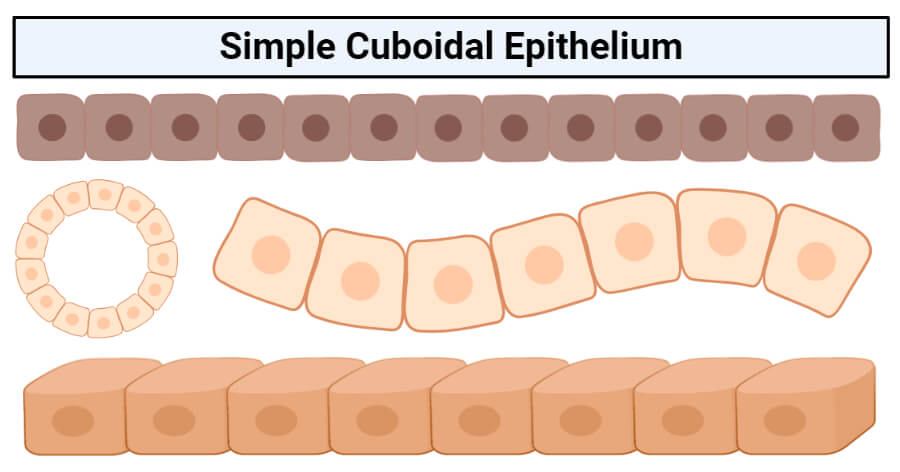
Interesting Science Videos
Simple cuboidal epithelium definition
Simple cuboidal epithelium is a type of simple epithelium consisting of cube-shaped cells with rounds and more or less centrally located nucleus. They are mostly derived to suit the function of the particular organs better. Because the simple cuboidal epithelium has a single layer of cells, all the cube-shaped cells are directly attached to the basement membrane.
Structure of the simple cuboidal epithelium
- The cells in the cuboidal epithelium are not strictly cubical as those cells cannot form the ducts. However, they are roughly as tall as they are wide.
- The cells are thicker with a somewhat larger and round centrally located nucleus.
- The shape and size of the cells are similar, each more or less cube-like in form.
- Their greater thickness allows cytoplasm to be abundant in mitochondria and other organelles for a high level of active transport across the epithelium and other functions.
- The cells are tightly packed with practically no intracellular space between two cells as the epithelium acts as a protective layer or lining.
- As in all other types of epithelial tissues, the apical surface of the cells in the cuboidal epithelium is located towards the lumen of the organs or ducts while the lateral surface is provided with adhesions and junctions to facilitate the connection between the adjacent cells.
- Cells in the simple cuboidal epithelium in some parts like the tissue in the respiratory bronchioles and the tubules in the kidneys are ciliated on the apical surface.
- The cilia are typically 5-10 μm long and 0.2 μm in diameter. Each cilium has a core structure consisting of nine peripheral microtubule doublets arrayed around by two central microtubules.
- Cilia exhibit rapid beating patterns that move a current of fluid and suspended matter in one direction along the epithelium.
- These cilia direct the movement of molecules in a particular direction aids the function of excretion and secretion.
- The cells in the simple cuboidal epithelium do not have a direct blood supply. Still, they get their nutrients, water, and gases from the underlying tissue via diffusion as they are directly attached to the basement membrane.
- The cells, however, are innervated, having a nerve supply.
Functions of the simple cuboidal epithelium
Owing to the shape of the cells, the primary functions of the simple cuboidal epithelium are secretion, absorption, and covering.
1. Covering/ Protection
- They function as a covering for several organs providing protection against damage and other chemicals.
- The cuboidal epithelium in the ovaries forms the ovarian surface that functions in replacing and repairing the damage caused by the ovulation and supports the function of the ovum in the ovary.
- They also cover the outer lining of the seminiferous tubules in the testes.
- The cuboidal epithelium in other parts like the lining of the ducts in the respiratory tract provides a lining and covers the internal structure, providing protection against mechanical wear and tear.
2. Secretion
- They also perform the function of producing biologically active fluids like the cerebrospinal fluid and the hormones.
- The cuboidal epithelium in the thyroid glands is an example of this where the cells line the thyroid follicles responsible for the production of thyroid hormone.
- The ependyma in the brain is formed by a single layer of the cuboidal cells that produce the cerebrospinal fluid.
3. Excretion
- They also function in excretion as it excretes the harmful by-products into the urine in the kidneys.
- Similarly, the lining of the sweat and sebaceous glands is also a derivative of the simple cuboidal epithelium that functions in the production of sweat and oil products.
- A large number of mitochondria and other organelles facilitate the process of active transport required for the removal of various molecules.
4. Absorption
- Depending on the location, the cells of the simple cuboidal epithelium may be involved in either active or passive transport of materials.
- The proximal convoluted tubules and distal convoluted tubules in the kidneys, lined with the simple cuboidal epithelium remove the excess water and other waste materials and also maintain the pH and ion balance of the body.
- The cilia present in the apical surface of the cells of the cuboidal epithelium in the kidneys that aid the absorptive function.
Location and Examples of Simple cuboidal epithelium
- They are present throughout the body, modified according to the function of the organs.
- They line the respiratory tract, tubules of the kidneys, and smaller ducts of many other glands, providing coverage as well as excretory and absorptive functions.
- Similarly, the thyroid follicle in the thyroid glands is another example of simple cuboidal epithelium.
- They cover the surface of the ovary, epididymis, and parts of the testes.
- In the same way, this epithelium is also present in the anterior surface of the capsule of the lens of the eye, and it also forms the pigmented epithelium at the posterior surface of the retina of the eye.
- They also make up the secreting portion of some glands like the thyroid gland and the pancreas.
References and Sources
- Mescher AL (2016). Basic Histology. Fourteenth Edition. McGraw-Hill Education.
- Tortora GJ and Derrickson B (2017). Principles of Physiology and Anatomy. Fifteenth Edition. John Wiley & Sons, Inc.
- Waugh A and Grant A. (2004) Anatomy and Physiology. Ninth Edition. Churchill Livingstone.
- 3% – https://quizlet.com/147667159/chapter-4-epithelium-flash-cards/
- 2% – https://quizlet.com/157579600/epithelial-tissues-quiz-flash-cards/
- 1% – https://www.lecturio.com/magazine/epithelium/
- 1% – https://wikimili.com/en/Simple_cuboidal_epithelium
- 1% – https://quizlet.com/44569319/ap-i-chapter-4-flash-cards/
- 1% – https://jcs.biologists.org/content/117/13/2791
- <1% – https://www.toppr.com/guides/biology/tissues/epithelial-tissue/
- <1% – https://www.slideshare.net/farhanali911/epithelium-33461392
- <1% – https://www.onlinebiologynotes.com/types-epithelial-tissue-simple-compound-specialized/
- <1% – https://www.kenhub.com/en/library/anatomy/overview-and-types-of-epithelial-tissue
- <1% – https://quizlet.com/43755933/chapter-4-integumentary-system-flash-cards/
- <1% – https://quizlet.com/158171594/plasma-membrane-study-questions-flash-cards/
- <1% – https://courses.lumenlearning.com/boundless-ap/chapter/epithelial-tissue/
